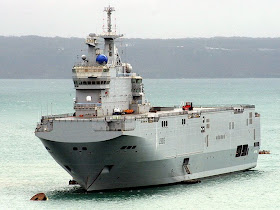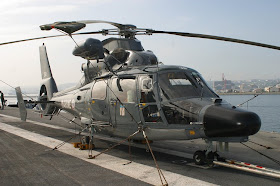Aircraft carrier class Invincible built the first of the carrier category Invincible in building Basin Vickers Shipbuilding. And entered service in July 1980.
And carried the name HMS Invincible And carried the second carrier HMS name Elistruiz, and the third name HMS Ark Royal; Benita in the basin Swan Hunter, in 1982, 1985. Cost carriers of this class command and control task for a group fighting sea. And offers listed for take-off and landing vertical take-off aircraft, and helicopters.
Armed the three carriers, in the beginning, surface missile system / Joe, ever dual Pitcher. However, this system was removed later, to lengthen the flight deck, so the carrier can receive aircraft of the type Harrier GR 7.
Category carriers equipped with three central defense systems, of the kind Phalanx MK - 15, in addition to the cannon GAM B01 caliber of 20 mm. The carrier can accommodate nine aircraft of the type Harrier GR - 7, or Sea Harrier F/A2; and nine helicopters type Sea King HAS - 6, equipped to fight submarines; and three aircraft Sea King AEW - 2, equipped with warning systems and early warning. It has been tested landing and takeoff vertical modern Merlin HM1 on this category of carriers, and will replace existing aircraft, since 2005. These carriers feature a surface fly, 170-meter-long, deflected the buttocks to the top at an angle of 12 degrees, to help take-off aircraft. Carriers used four engines produced by Rolls Royce-type turbine TM 3B, which works with gasoline fuel.
1. Country of Origin: United Kingdom.
2. Use: aircraft carrier, to serve as a command center for maritime groups fighting.
3. States used: the United Kingdom.
Ships in class:
:: HMS Invincible ::
Builders: Vickers Shipbuilding and Engineering in Barrow-in-Furness
Laid down: 20 July 1973
Launched: 8 May 1977
Operator: Royal Navy
Commissioned: 11 July 1980
Decommissioned: 3 August 2005
Status: Scrapped 2011
Modifications: Lengthened flight deck, removal of Sea Dart SAM, addition of three Goalkeeper CIWS
Operations: Falklands War, Operation Deny Flight, Operation Deliberate Force, Operation Bolton, Operation Allied Force
Victories: 21 Argentine aircraft during Falklands War.
:: HMS Illustrious ::
Builders: Swan Hunter on the River Tyne
Laid down: 7 October 1976
Launched: 14 December 1978
Operator: Royal Navy
Commissioned: 20 June 1982
Status: In active service, based at Portsmouth
Modifications: Lengthened flight deck, removal of Sea Dart SAM, addition of three Goalkeeper CIWS
Operations: Bosnia, Operation Palliser, Evacuation of British Citizens from Beirut (Israeli-Lebanon Conflict 2006)
:: HMS Ark Royal ::
Builders: Swan Hunter in Wallsend
Laid down: 14 December 1978
Launched: 2 June 1981
Operator: Royal Navy
Commissioned: 1 November 1985
Status: Scrapped 2013
Modifications: Enlarged flight deck, removal of Sea Dart SAM, addition of three Phalanx CIWS
Operations: 1993-1994 Operation Deny Flight, 2003 invasion of Iraq - Operation Telic.
+(3).jpg)
+01.jpg)
+(2).jpg)

+(4).jpg)
+(5).jpg)
.jpg)


.jpg)
.jpg)
.jpg)
.jpg)
.jpg)

.jpg)
.jpg)



+(4).jpg)
+(2).jpg)
+(3).jpg)
+(5).jpg)
+(6).jpg)
+(7).jpg)
+(8).jpg)
.jpg)










+(2).jpg)
+(3).jpg)
.jpg)
+(2).JPG)